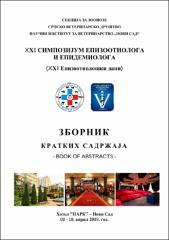| dcterms.abstract | The constant circulation of Western Nile virus (VZN) has been detected in the last
few years in Serbia. Bigger or smaller epidemics have been reported in human
population in Serbia since 2012, until today. The veterinary service in Serbia launched
a national program for WNV monitoring in June 2018, and it was continuation of the
monitoring programs from 2014, 2015 and 2017. Program is funded by the Veterinary
Directorate, and it is implemented on the field by veterinary service in collaboration
with entomologists and ornithologists. The main objective of the monitoring program
was the early detection of the presence of WNV in a certain area, and consequently
timely alerting of human health services and local governments in order to control the
mosquito population and to inform the local communities.
The monitoring program was based on the direct and indirect monitoring of the
presence of WNV in nature. Indirect monitoring of virus presence was performed by
serological testing of horses on the presence of anti-WNV IgM antibodies as the
confirmation of acute infection. Direct monitoring of the WNV presence in nature was
done by molecular testing of WNV presence in pooled mosquito’s samples and in
wild birds in active surveillance and by testing the samples of clinically suspected
horses in passive surveillance. Number of tested samples is defined at the level of each
district of the Republic of Serbia in relation to the risks of WNV infection.
In the period June-September 2018 in Serbia, according to the program, 2511 blood
sera of horses were tested, and seroconversion (IgM antibodies) was detected in 44
(1.75%) horses. The seroconversion was in the ascendant order with increasing the
activity of the vectors and positive serological response were determined in June in
1.19% (7/587), in July in 2.77% (18/648), in August in 2.16% (14/646), and in
September in 0.79% (5/630) of tested horses. The number of districts where the
positive horses were detected was: 4 in June, 8 in July, 7 in August and 3 in September.
In direct monitoring of virus presence, 802 pools of mosquitoes were tested from June
to September 2018, and WNV was confirmed in 98 (12.21%) samples. The prevalence
of WNV in mosquitoes has increased since the first positive findings detected in June
(8.82%; 15/170), 15.05% (59/392) mosquito samples were tested positive in July,
11.42% (24/210) in August, and 0% (0/30) in September. Positive mosquito samples.were detected in 13 out of 25 districts of Serbia: 17.91% positive / tested samples was
detected in South Bačka, 19.05% in North Banat, 21.33 in Western Bačka, 21.82% in
North Bačka, 22.72% in South Banat, 25% in Mačva and 26.42% in Central Banat
District; 24.39% positive pools were found in area of Belgrade and ≥ 10% WNV
positive mosquito pools were detected in Sremski, Podunavski, Pomoravski, Raški
and Moravica District. Among 155 samples of found dead wild birds, WNV was
detected in 18 (11.66%) birds from 8 Districts. WNV was also detected in 13 (6.56%)
out of 198 tested samples of pharyngeal swabs of live wild bird sampled on the area
of 5 Districts. Among 12 samples of hunted wild birds, from the territory of 1 districts,
WNV was not detected. WNV was detected in hooded crows, common kestrels,
Eurasian magpies, great tit, common blackbird, Eurasian jay and long-eared owl.
WNV monitoring program during 2018 was proved as successful and meaningful and
it is necessary to continue and improve it in the forthcoming period in order to ensure
the timely protection of human and animal health. | En |

